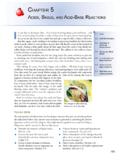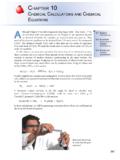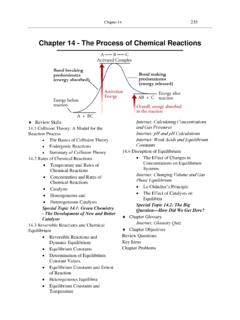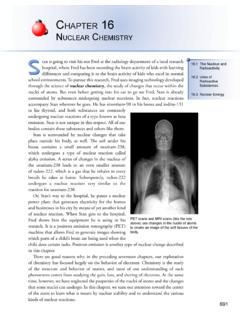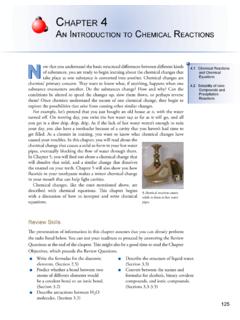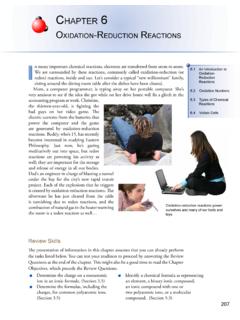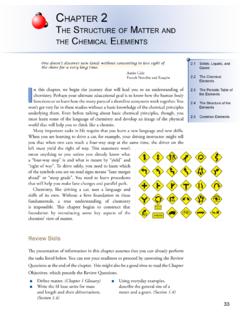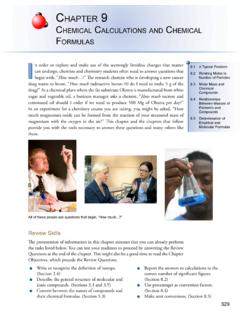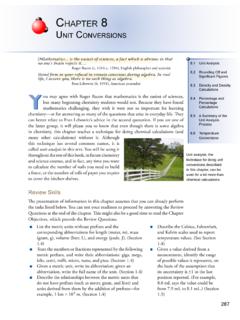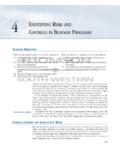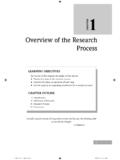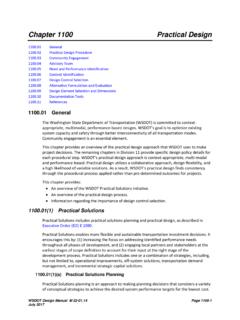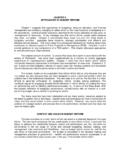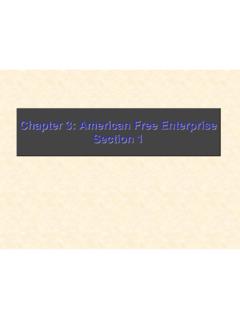Transcription of Chapter 6 Oxidation-Reduction Reactions
1 65. Chapter 6. Oxidation-Reduction Reactions Review Skills An Introduction to Oxidation-Reduction Reactions oxidation , reduction , and the Formation of Binary Ionic Compounds Oxidation-Reduction and Molecular Compounds Special Topic : Oxidizing Agents and Aging oxidation Numbers Internet: Balancing Redox Reactions Types of Chemical Reactions Combination Reactions Decomposition Reactions Combustion Reactions Special Topic : Air Pollution and Catalytic Converters Single-Displacement Reactions Internet: Single-Displacement Reaction Voltaic Cells Dry Cells Electrolysis Nickel-Cadmium Batteries Special Topic : Zinc-Air Batteries Chapter Glossary Internet: Glossary Quiz Chapter Objectives Review Questions Key Ideas Chapter Problems 66 Study Guide for An Introduction to Chemistry Section Goals and Introductions Section An Introduction to Oxidation-Reduction Reactions Goals To describe what oxidation and reduction mean to the chemist. To describe chemical Reactions for which electrons are transferred ( Oxidation-Reduction Reactions ).
2 To describe oxidizing agents and reducing agents. In many chemical Reactions , electrons are completely or partially transferred from one atom to another. These Reactions are called Oxidation-Reduction Reactions (or redox Reactions ). This section provides examples of these Reactions and introduces the terms oxidation , reduction , oxidizing agent, and reducing agent, which are summarized in Figure Section oxidation Numbers Goal: To describe what oxidation numbers are, how they can be determined, and how they can be used to determine (1) whether the reaction is an Oxidation-Reduction reaction, (2) what is oxidized in an Oxidation-Reduction reaction, (3) what is reduced in an Oxidation-Reduction reaction, (4) what the oxidizing agent is in an Oxidation-Reduction reaction, and (5) what the reducing agent is in an Oxidation-Reduction reaction. oxidation numbers, which are described in this section, provide a tool that allows you to determine the things mentioned in the goal above. Sample Study Sheet : Assignment of oxidation Numbers and Tables and , which support the study sheet, summarize the process.
3 The section on our Web site called Balancing Equations for Redox Reaction describes how you can use oxidation numbers. Internet: Balancing Redox Reactions Section Types of Chemical Reactions Goal: To describe different types of chemical Reactions . Chemical Reactions can be classified into types of similar Reactions . This section describes some of these types: combination, decomposition, combustion, and single-displacement Reactions . You will learn how to identify each type of reaction from chemical equations. The section also describes how you can write chemical equations for combustion Reactions (Study Sheet ). The attempt to help you visualize chemical changes on the particle level continues with a description of the single-displacement reaction between solid zinc and aqueous copper(II) sulfate (Figure ). The animation on our Web site called Single-Displacement Reactions will help you visualize single-displacement Reactions . Internet: Single-Displacement Reaction Section Voltaic Cells Goal: To show how Oxidation-Reduction Reactions can be used to create voltaic cells that is, batteries.
4 This is one of the sections that are spread throughout the text that show you how what you are learning relates to the real world. In this case, you see how electrons transferred in Oxidation-Reduction Reactions can be made to pass through a wire that separates the reactants, Chapter 6 Oxidation-Reduction Reactions 67. thus creating a voltaic cell, which is often called a battery. This section describes the fundamental components of voltaic cells and describes several different types. Chapter 6 Map 68 Study Guide for An Introduction to Chemistry Chapter Checklist Read the Review Skills section. If there is any skill mentioned that you have not yet mastered, review the material on that topic before reading this Chapter . Read the Chapter quickly before the lecture that describes it. Attend class meetings, take notes, and participate in class discussions. Work the Chapter Exercises, perhaps using the Chapter Examples as guides. Study the Chapter Glossary and test yourself on our Web site: Internet: Glossary Quiz Study all of the Chapter Objectives.
5 You might want to write a description of how you will meet each objective. (Although it is best to master all of the objectives, the following objectives are especially important because they pertain to skills that you will need while studying other chapters of this text: 7 and 8.). Reread the Study Sheets in this Chapter and decide whether you will use them or some variation on them to complete the tasks they describe. Sample Study Sheet : Assignment of oxidation Numbers Sample Study Sheet : Writing Equations for Combustion Reactions Memorize the guidelines in Table for assigning oxidation numbers. To get a review of the most important topics in the Chapter , fill in the blanks in the Key Ideas section. Work all of the selected problems at the end of the Chapter , and check your answers with the solutions provided in this Chapter of the study guide. Ask for help if you need it. Web Resources Internet: Balancing Equations for Redox Reactions Internet: Single-Displacement Reaction Internet: Glossary Quiz Chapter 6 Oxidation-Reduction Reactions 69.
6 Exercises Key Exercise - oxidation Numbers: In one part of the steel manufacturing process, carbon is combined with iron to form pig iron. Pig iron is easier to work with than pure iron because it has a lower melting point (about 1130 C, compared to 1539 C for pure iron) and is more pliable. The following equations describe its formation. Determine the oxidation number for each atom in the formulas. Decide whether each reaction is a redox reaction, and if it is, identify what is oxidized, what is reduced, what the oxidizing agent is, and what the reducing agent is. (Obj 3). 2C(s) O2(g) 2CO(g). Fe2O3(s) 3CO(g) 2Fe(l) 3CO2(g). 2CO(g) C(in iron) CO2(g). Solution: Atoms in pure elements have an oxidation number of zero, so the C atoms in C(s) and C(in iron), the O atoms in O2, and the Fe atoms in Fe(s) have an oxidation number of zero. Oxygen atoms combined with other elements in compounds have an oxidation number of 2 (except in peroxides), so each O atom in CO, Fe2O3, and CO2 has an oxidation number of 2.
7 Each Fe ion in Fe2O3 has a +3 charge, so each has an oxidation number of +3. Because the sum of the oxidation number of the atoms in an uncharged molecule is zero, each C atom in CO must have an oxidation number of +2, and each C atom in CO2. must have an oxidation number of +4. The oxidation numbers for each atom are above their symbols in the equations below. 0 0 +2 2. 2C(s) + O2(g) 2CO(g). +3 2 +2 2 0 +4 2. Fe2O3(s) + CO(g) 2Fe(l) + 3CO2(g). +2 2 0 +4 2. 2CO(g) C(in iron) CO2(g). They are all redox Reactions . In the first reaction, each carbon atom increases its oxidation number from 0 to +2, so C(s) is oxidized and is the reducing agent. Each oxygen atom decreases its oxidation number from 0 to 2, so O2 is reduced and is the oxidizing agent. In the second reaction, each carbon atom increases its oxidation number from +2 to +4, so each carbon atom in CO(g) is oxidized, and CO(g) is the reducing agent. Each iron atom in Fe2O3 decreases its oxidation number from +3 to 0, so each Fe atom in Fe2O3 is reduced, and Fe2O3 is the oxidizing agent.
8 Because there is only one reactant in the third reaction, it is different from the other two. Some of the carbon atoms in CO(g) are oxidized from +2 to +4, and some of them are reduced from +2 to 0. Thus carbon atoms in CO are both oxidized and reduced, and CO is both the oxidizing agent and the reducing agent. 70 Study Guide for An Introduction to Chemistry Exercise - Combustion Reactions : Write balanced equations for the complete combustion of (a) C4H10(g), (b) C3H7OH(l), and (c) C4H9SH(l). (Obj 8). Solution: a. 2C4H10(g) 13O2(g) 8CO2(g) 10H2O(l). b. 2C3H7OH(l) 9O2(g) 6CO2(g) 8H2O(l). c. 2C4H9SH(l) 15O2(g) 8CO2(g) 10H2O(l) 2SO2(g). Exercise - Classification of Chemical Reactions : Classify each of these Reactions as a combination reaction, a decomposition reaction, a combustion reaction, or a single-displacement reaction. (Obj 7).. a. 2 HgO(s) 2Hg(l) O2(g) decomposition b. C12H22O11(s) 12O2(g) 12CO2(g) 11H2O(l) combustion . c. B2O3(s) 3Mg(s) 2B(s) 3 MgO(s) single-displacement d. C2H4(g) H2(g) C2H6(g) combination Review Questions Key 1.
9 For each of the following ionic formulas, write the formula for the cation and the formula for the anion. a. FeBr3 Fe3 and Br c. AgCl Ag and Cl . b. Co3(PO4)2 Co2 and PO43 d. (NH4)2SO4 NH4 and SO42 . 2. Classify each of the following formulas as representing a binary ionic compound, an ionic compound with polyatomic ions, or a molecular compound. a. CF4 molecular e. H2S molecular b. Pb(C2H3O2)2 ionic with f. ClF molecular polyatomic ion g. Cr(OH)3 ionic with polyatomic ion c. CoCl2 binary ionic h. H3PO4 molecular d. C2H5OH molecular 3. Balance the following equations. (C8H18 is a component of gasoline, and P2S5 is used to make the insecticides parathion and malathion.). a. C8H18(l) 25/2O2(g) 8CO2(g) 9H2O(l). or 2C8H18(l) 25O2(g) 16CO2(g) 18H2O(l). b. 4P4(s) 5S8(s) 8P2S5(s). Chapter 6 Oxidation-Reduction Reactions 71. Key Ideas Answers 4. According to the modern convention, any chemical change in which an element loses electrons is called an oxidation . 6. Electrons are rarely found unattached to atoms.
10 Thus, for one element or compound to lose electrons and be oxidized, another element or compound must be there to gain the electrons and be reduced. In other words, oxidation (loss of electrons) must be accompanied by reduction (gain of electrons). 8. The separate oxidation and reduction equations are called half- Reactions . 10. A(n) oxidizing agent is a substance that gains electrons, making it possible for another substance to lose electrons and be oxidized. 12. Just think of oxidation numbers as tools for keeping track of the flow of electrons in redox Reactions . 14. In combination Reactions , two or more elements or compounds combine to form one compound. 16. In a combustion reaction, oxidation is very rapid and is accompanied by heat and usually light. 18. When a substance that contains hydrogen is burned completely, the hydrogen forms water. 20. In single-displacement Reactions , atoms of one element in a compound are displaced (or replaced) by atoms from a(n) pure element. 21. Strictly speaking, a battery is a series of voltaic cells joined in such a way that they work together.
